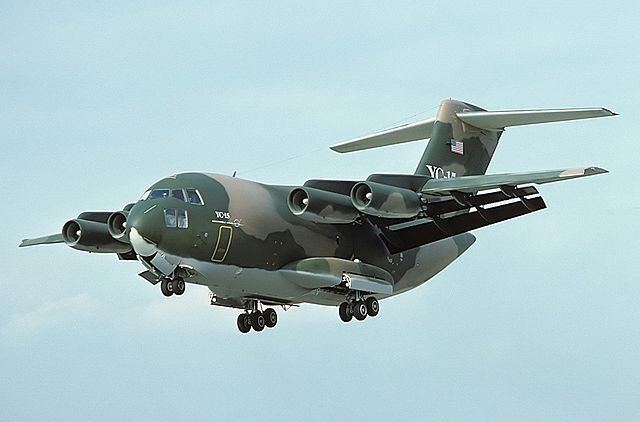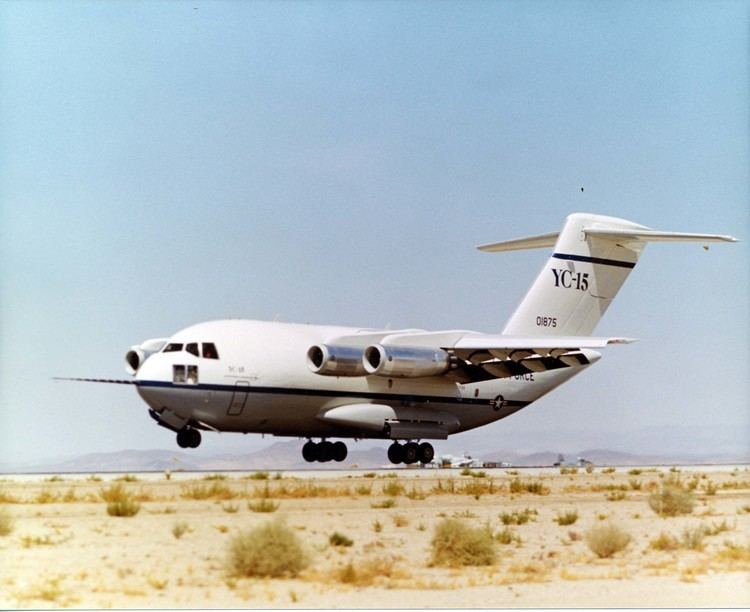Top speed 950 km/h Wingspan 40 m Cruise speed 861 km/h First flight August 26, 1975 | Range 4,810 km Length 38 m Engine type Pratt & Whitney JT8D | |
 | ||
Mcdonnell douglas yc 15
The McDonnell Douglas YC-15 was a four-engine short take-off and landing (STOL) tactical transport. It was McDonnell Douglas' entrant into the United States Air Force's Advanced Medium STOL Transport (AMST) competition to replace the Lockheed C-130 Hercules as the USAF's standard STOL tactical transport. In the end, neither the YC-15 nor the Boeing YC-14 was ordered into production, although the YC-15's basic design would be used to form the successful C-17 Globemaster III.
Contents
- Mcdonnell douglas yc 15
- Mcdonnell douglas yc 15 stol tactical transport
- Design and development
- Operational history
- Specifications
- References

Mcdonnell douglas yc 15 stol tactical transport
Design and development

In 1968, the USAF started work on a series of prototype proposals, which would lead to both the AMST project and the Light Weight Fighter. The official Request for proposal (RFP) was issued in January 1972, asking for operations into a 2,000 feet (610 m) semi-prepared field with a 27,000 lb (12,000 kg) payload and a 400 nmi (740 km) mission radius. For comparison, the C-130 of that era required about 4,000 ft (1,200 m) for this load. Proposals were submitted by Bell, Boeing, Fairchild, McDonnell Douglas and the Lockheed/North American Rockwell team at this stage of the competition. On 10 November 1972, the two top bids (from Boeing and McDonnell Douglas) were selected. The companies were awarded development contracts for two prototypes each. McDonnell Douglas' prototype was designated YC-15.

McDonnell Douglas's design incorporated a supercritical wing, the result of NASA research carried out by the already famous Richard Whitcomb. This wing design dramatically lowers transonic wave drag by as much as 30% compared to more conventional profiles, while at the same time offering excellent low-speed lift. Most contemporary aircraft used swept wings to lower wave drag, but this led to poor low-speed handling, which made them unsuitable for STOL operations.
The design team also chose to use externally blown flaps to increase lift. This system uses double-slotted flaps to direct part of the jet exhaust downwards, while the rest of the exhaust passed through the flap and then followed the downward curve due to the Coandă effect. Although the effects had been studied for some time at NASA, along with similar concepts, until the introduction of the turbofan the hot and concentrated exhaust of existing engines made the system difficult to use. By the time of the AMST project, engines had changed dramatically and now provided larger volumes of less-concentrated and much cooler air. For the YC-15, four engines were used, versions of the Pratt & Whitney JT8D-17 widely used on the Boeing 727 and Douglas DC-9. The YC-15 borrowed components from other McDonnell Douglas aircraft, with its nose gear coming from the Douglas DC-8 and the nose section & cockpit being derived from the Douglas DC-10. Parts borrowed from other aircraft included the Universal Aerial Refueling Receptacle Slipway Installation (UARRSI), taken from a Fairchild A-10, anti-tipover stabilizer struts from the Lockheed C-141 Starlifter, pumps taken from the McDonnell Douglas F-15 Eagle, Lockheed C-5 Galaxy, DC-9 and C-141 and actuators taken from the C-5 Galaxy and DC-10. In addition, the environmental cooling system was composed of components taken from the DC-9, C-141 and Boeing KC-135.
Operational history
Two YC-15s were built, one with a wingspan of 110 feet (#72-1876) and one with 132 feet (#72-1875). Both were 124 feet (38 m) long and powered by four Pratt & Whitney JT8D-17 engines, each with 15,500 lbf (68.9 kN) of thrust.
The first flight was on 26 August 1975. The second prototype followed in December. They were tested for some time at McDonnell Douglas as the Boeing entry was not ready until almost a year later. In November 1976, both designs were transferred to Edwards Air Force Base for head-to-head testing, including lifting heavy loads like tanks and artillery from dirt airfields at Graham Ranch, off the end of Runway 22.
In Phase II of the flight test program, a "refanned" Pratt & Whitney JT8D-209 was tested in No. 1 nacelle of 72–1876 and a CFM International CFM56 was tested in the No. 1 nacelle of 72–1875. In addition, a new wing with increased chord and span was flown on 72-1875.
The YC-15s completed a 600-hour flight test program in 1977. By this point, the seeds of the AMST program's demise had already been sown. In March 1976, the Air Force Chief of Staff, Gen. David C. Jones, asked the Air Force Systems Command to see if it was possible to use a single model of the AMST for both strategic and tactical airlift roles, or alternatively, if it was possible to develop non-STOL derivatives of the AMST for the strategic airlift role. This led to a series of studies that basically stated that such a modification was not easy, and would require major changes to either design to produce a much larger aircraft.
Both the YC-14 and YC-15 met or exceeded the AMST specifications under most conditions. However, the increasing importance of the strategic vs. tactical mission eventually led to the end of the AMST program in December 1979. Then, in November 1979, the C-X Task Force formed to develop the required strategic aircraft with tactical capability. The C-X program selected a proposal for an enlarged and upgraded YC-15 that was later developed into the C-17 Globemaster III. The Lockheed C-130 Hercules would be further improved and remains in service as of 2016.
After the flight test program, the two aircraft were stored at the AMARC, located at Davis-Monthan Air Force Base. One aircraft (72-1875) was subsequently moved to the nearby Pima Air & Space Museum in 1981, but was returned to flying status by McDonnell Douglas in 1996; and was first reflown on 11 April 1997. On 16 April 1997, the aircraft was ferried to Long Beach, California to support the C-17 program. On 11 July 1998, the aircraft suffered a massive failure of the No. 1 engine during flight and made an emergency landing at Palmdale, California. On inspection, the aircraft was deemed too expensive to repair and was stored at Palmdale. In 2008, it was moved by road to Edwards AFB, where it is now on display at the Air Force Flight Test Center Museum's "Century Circle" display area, just outside the base's west gate. The other airframe (72–1876), which had remained on Celebrity Row at the AMARC for many years, was destroyed in place in April 2012. It was within easy towing distance of the Pima Air Museum, which had hosted its sister for almost 15 years, but no efforts were made to transfer the aircraft there instead of destroying it.
Specifications
Data from The Observer's Book of Aircraft
General characteristics
Performance
